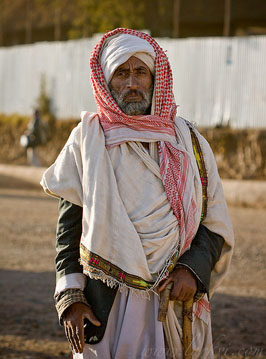
Muslim Hadramis in “Christian Ethiopiaâ€: Reflections on Boundary Making Processes
by Samson A. Bezabeh, Bergen University
[Note: This is the Introduction to a recent article on the Hadrami experience in Ethiopia. The full article can be downloaded from the Journal of Muslim Minority Affairs.]
Introduction
Throughout recorded history sporadic population migration from Arabia to East Africa and Ethiopia has been a noted phenomenon. In the modern era Hadramis started to migrate and settle in Ethiopia at the end of the nineteenth century and the beginning of the twentieth century. Thus, by the beginning of the twentieth century, Ethiopia hosted a number of Arab families who were mainly Yemeni or Hadrami by origin. Although the exact population of the Hadramis at that time is not known, various statistical estimates and narrations, including narration of present day Hadrami families indicate that their number was substantial. This is particularly true in the case of major Ethiopian towns and trading centres such as Harar, Jimma and Asmara.
Despite their pronounced presence, however, their numbers, declined during the second half of the twentieth century as a result of negative factors that have forced them to leave the country. One such factor was the movement of pan-Arab nationalism which gained momentum in the 1960s. To be more specific, in 1969 Hadramis were expelled from Ethiopia for “supporting†the Eritrean Liberation Front (ELF), whom Arab nations, particularly Syrians and Egyptians, were supporting for fulfilling their goal of creating a united Arab land which in their vision also included the highlands of northern Ethiopia. In this scenario, Hadramis along with other Arabs were accused by the Haile Selassie regime4 in Ethiopia of sympathizing with the Arab backers of the Eritrean Liberation Front (ELF), and hence undermining Ethiopian unity. This has led many Hadrami families to voluntarily and involuntarily relocate themselves to Yemen and to oil reach countries in the Gulf such as Saudi Arabia.
In addition to the above circumstances, the socialist regime that came to power in 1974 resulted in the out migration of Hadrami families. In the 1970s, the regime that referred to itself as Derg, nationalized business establishments and private houses through a series of declarations. Hadrami merchants and traders were also faced with a hostile environment as they were referred as “the bourgeoisie†who were oppressing the newly championed class, the proletariat and the farmers. The Red Terror Campaign which was executed by the Derg regime and which has led to the killing of half a million people also presented a harsh environment for the Hadramis. In these circumstances many Hadramis lost their property and many became casualties of the Red Terror regime.
Despite their out migration, Ethiopia still hosts a number of Hadrami families. Many of the present day Hadramis are descendents of families who have resisted the atrocities and challenges that occurred in the 1960s and 1970s. There are also families who went to Saudi Arabia and Yemen but returned back to Ethiopia following the down fall of the Derg regime and the take over by the Ethiopian People’s Revolutionary Democratic Front (EPRDF) in 1991, a political force that presented a more liberalized framework reflecting the post Cold War political environment.
In this article I will describe what it means to be a Hadrami from and in Ethiopia in the above mentioned historical and/or political contexts. To be more specific, in the following pages, I will try to show how Hadrami families have been affected by processes of exclusion and of stigmatization and of boundary making process effected both by the state policies and the state administrative set up as well as through the organization of everyday interaction.
For the sake of clarity and coherence I will present the discussion by focusing on three time lines:
A) The imperial period: A period which spans from the coming of the Hadramis at the beginning of the twentieth century to the down fall of Emperor Haile Sellassie and the take over of the socialist oriented Derg in 1974. This period present to us a conceptual arena in which the Ethiopian state is portrayed as a Christian Kingdom as a result of a monarchical system which is strongly linked with the Ethiopian Orthodox church, an alliance which has been formed since the introduction of Christianity in Ethiopian during the fourth century.
B) From 1960s to 1990s: In this period I will try to look at what it means to be a Hadrami when the situation became harsh in Ethiopia. As Hadramis have also moved from Ethiopia to places like Yemen and Saudi Arabia during this period, I will also try to relate their experience of being Hadramis from Ethiopia in those new contexts.
C) From 1990s to 2008: In this section I will try to shed light on what it means to be a Hadrami in a context where the government in power namely the current government led by EPRDF portrays itself as being follower of democratic ideals and committed to the separation of state and religion. The narration in this section also considers contemporary events mainly the Ethiopian invasion of Somalia which occurred in a post 9/11 environment.
The full article can be found in Journal of Muslim Minority Affairs, Vol. 30, No. 3, September 2010, pp. 333-342. The full article can be purchased at http://www.tandfonline.com/doi/abs/10.1080/13602004.2010.515813